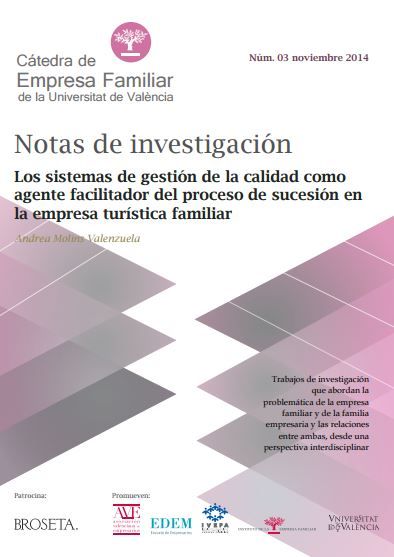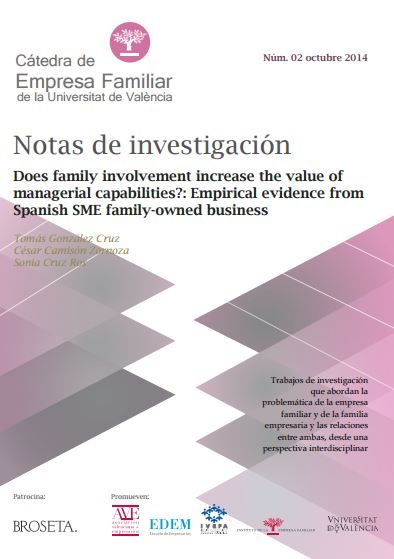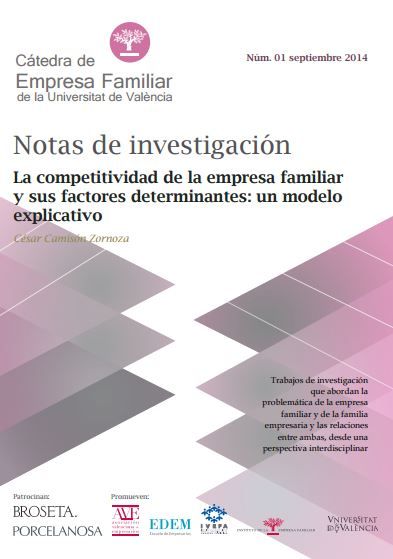Search result13 results
-

Note research 03/2014: Els sistemes de gestió de la qualitat com agent facilitador del procés de succesió a la empresa turística familiar
Molins, Andrea
(2014). ArticleEls sistemes de gestió de la qualitat com agent facilitador del procés de succesió a la empresa turística familiar. Family Business Chair, Universitat de València. No.3. November 2014
The succession process in the family business is one of the defining moments for the continuity of the company, especially in those first generation companies in which the founder will give way to his inheritors in the management of the company. The present paper aims to study those High Performance Practices, typical of Quality Management Systems, which can make the probability of success for the generational change process of tourist companies greater. The area under study is the Spanish tourism industry, relevant sector in recent decades as one of the largest contributor to the country's economy.
Legal deposit: V109-2015
ISBN: 978-84-697-1277-1 -

Research note 02/2014: Does family involvement increase the value of managerial capabilities? Empirical evidence from Spanish SME family-owned business
Camisón Zornoza, César
(2014). ArticleThe influence of the owner-family over Family-Owned Business performance issue has received recent research attention. Fewer are the amount of research devoted to analyse the owner-family effect over firm’s managerial capabilities (MC). This paper contributes to this vein of research analysing a sample of Spanish SME-FOB. It contributes differentiating family involvement depending on the organizational role and making a whole consideration of MC. Also it considers family complexity. Results show that family involvement produces a negative impact over MC. However it turns positive when ownership-management roles are differentiated and proper family governance structures deployed. Two...
The influence of the owner-family over Family-Owned Business performance issue has received recent research attention. Fewer are the amount of research devoted to analyse the owner-family effect over firm’s managerial capabilities (MC). This paper contributes to this vein of research analysing a sample of Spanish SME-FOB. It contributes differentiating family involvement depending on the organizational role and making a whole consideration of MC. Also it considers family complexity. Results show that family involvement produces a negative impact over MC. However it turns positive when ownership-management roles are differentiated and proper family governance structures deployed. Two findings should be highlighted: family complexity appears as extremely harmful for MC, and family governance structures only increase MC when it fit with the level of family complexity, in other case, an oversized family governance structure damages MC.
Read more HideDepòsit legal: V108-2015
ISBN: 978-84-697-1276-4 -

Note reserch 01/2014: La competitivitat de la empresa familiar i els seus factors determinants: un model explicatiu
Camisón Zornoza, César
(2014). ArticleLa competitividad de la empresa familiar y sus factores determinantes: un modelo explicativo. Family Business Chair, Universitat de València. No.1. September 2014
This work is a contribution to the state of the problem of the origins of competitive asymmetries and the extraordinary results that rests on the inclusion within the explanatory factors of family effect. Its main contribution is to create a model that proposes a chained vision that includes both ex post competitiveness (horizontal approach) and its determinants in a multilevel causal chain (longitudinal approach) factors and ultimately leading to explain the international competitive success of the firm. This explanatory framework advocates an additive model integration of different sources of advantage over the competition and economic rents postulated by the various theories of the firm...
This work is a contribution to the state of the problem of the origins of competitive asymmetries and the extraordinary results that rests on the inclusion within the explanatory factors of family effect. Its main contribution is to create a model that proposes a chained vision that includes both ex post competitiveness (horizontal approach) and its determinants in a multilevel causal chain (longitudinal approach) factors and ultimately leading to explain the international competitive success of the firm. This explanatory framework advocates an additive model integration of different sources of advantage over the competition and economic rents postulated by the various theories of the firm applying them to the case of family business. Based on a fully specified theory, the study first discusses the complementarity of the country effects, industry, district, strategy and distinctive competencies. The theoretical model also clarifies the forces that influence the accumulation of sostenibles competitive advantages, especially focusing on the effect of the structure of ownership and control over the accumulation of intangible assets. This prism provides a consistent framework for analyzing the microeconomic sources of competitiveness of Family Business investigating the implications of family control in four needy research problems: the sign of the relationship between the character of Family Business and competitiveness of the firm, the factors determinants of competitiveness variability between Family Business and nonfamily firms, competitive advantages and disadvantages of each organizational form, and the provision of resources and capabilities that distinguishes Family Business of Non Family Business firms. In particular, with regard to the fourth problem identified, this paper justifies the distinctive profile of the portfolio of resources and capabilities between the two, predicting higher availability of the Family Business to investment in physical assets due to their preference for vertical integration and its disadvantage in financial resources and intangible assets, with particular intensity in managerial skills . The logical consequence of the lower endowment of intangible assets, coupled with their more limited financial capacity and greater reliance on external funding, would be that the Family Business is more dependent on the forces of the environment, for lack of springs to differentiate themselves in the market.
Read more HideLegal deposit: V110-2015
ISBN: 978-84-697-1275-7








